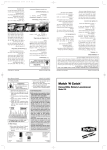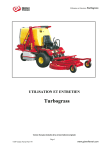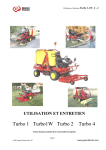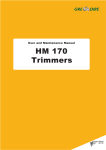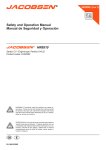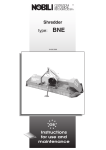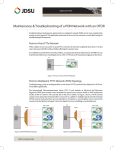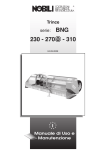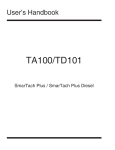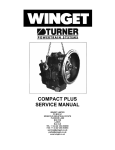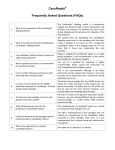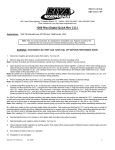Download Turbo 1 - 2
Transcript
USER MANUAL Turbo 1 - 2 - 4 ©GF Gianni Ferrari 10-2001 Operator’s Manual Turbo INDEX 1 IDENTIFICATION DATA 2 TO OUR CUSTOMERS 3 OPERATOR’S RESPONSIBILITIES 4 SAFETY REGULATIONS 5 TECHNICAL FEATURES 6 DIMENSIONS 7 TRANSPORT 8 CONTROLS AND INSTRUMENTS 9 STARTING AND USING THE MACHINE 10 GRASS CUTTING AND PICK-UP 11 PRACTICAL SUGGESTIONS 12 INSPECTIONS AND MAINTENANCE 13 MOUNTING THE MOWER DECK 14 MOWER DECK VERTICAL SETTING 15 BLADES REPLACEMENT - SHARPENING 16 HYDRAULIC LIFT FOR FRONT ATTACHMENTS 17 HYDRAULIC COLLECTOR DUMPING 18 HYDRAULIC COLLECTOR ELEVATOR 19 ACOUSTIC LEVEL AND VIBRATIONS 20 MAIN MAINTENANCE OPERATIONS 21 SAFETY LABELS Attached: Wiring diagram Engine operator’s manual Page 1 ©GF Gianni Ferrari 10-2001 1-2-4 Operator’s Manual Turbo 1-2-4 1 – IDENTIFICATION DATA CE mark with the above data consists of an indelible label affixed on the rear right side of the body. The serial number of the machine is stamped on the rear side of the right frame. Please indicate this number when requesting technical assistance or ordering spare parts. Serial number ……………………………………………….. TECHNICAL INFORMATION MODEL ENGINE DISPLACEMENT KW N° CYLINDER RPM TYPE FUEL TANK CAPACITY WEIGHT KG :BASE MACHINE DECK 130 CM DECK 150 CM DECK 160 CM COLLECTOR ELEVATOR GROUND CLEARENCE WHEEL DRIVE FRONT WHEELS REAR WHEELS FORWARD SPEED REVERSE SPEED Turbo 1 Lombardini Focs 1003 1028 cc 18.2 3 3000 4 – DIESEL 25 lt. KG. 690 130 150 160 100 110 cm. 17 2 23x10.50-12 16x6.50-8 Turbo 1 KUBOTA V 1105 1123 cc 18.7 3 3000 4 – DIESEL 25 lt. KG. 700 130 150 160 100 110 cm. 17 2 23x10.50-12 16x6.50-8 Turbo 2 Lombardini Focs 1404 1371 cc 22.5 4 3000 4 – DIESEL 25 lt. KG. 780 130 150 160 110 115 cm. 17 2 23x10.50-12 18x8.50-8 0-18 KM/H 0-9 KM/H Page 2 ©GF Gianni Ferrari 10-2001 Turbo 2 KUBOTA V 1505 1498 cc 25 4 3000 4 – DIESEL 25 lt. KG. 800 130 150 160 110 115 cm. 17 2 23x10.50-12 18x8.50-8 0-18 KM/H 0-9 KM/H Turbo 4 Lombardini Focs 1404 1371 cc 22.5 4 3000 4 – DIESEL 25 lt. KG. 840 130 150 160 110 115 cm. 17 4 23x10.50-12 18x8.50-8 0-18 KM/H 0-9 KM/H Turbo 4 KUBOTA V 1505 1498 cc 25 4 3000 4 – DIESEL 25 lt. KG. 860 130 150 160 110 115 cm. 17 4 23x10.50-12 18x8.50-8 0-18 KM/H 0-9 KM/H Operator’s Manual Turbo 1-2-4 2 – TO OUR CUSTOMERS - We are proud to welcome you amongst our customers. - Before starting work, the operator should become thoroughly familiar with the instructions in this manual in order to use and service the machine in the best possible way. - The machine has been designed and built in order to offer the best service in the most varied conditions. As always, the quality of the job will depend upon correct routine maintenance of the equipment. - Contact the dealer for specific information and advice on matters not covered in this handbook. He will be more than happy to offer assistance regarding use and maintenance of the machine. Turbo 1-2-4 is a professional self-propelled mower. This machine has been designed solely for grass cutting and care in parks and gardens, in the specifications described in this Operator’s Manual. The operator is responsible for any damage which may occur through improper use and operation outside the bounds of any instructions given in this manual. THIS SYMBOL IS USED TO DRAW YOUR ATTENTION TO THE SAFETY PRECAUTIONS WHICH MUST BE TAKEN BY THE OPERATOR TO AVOID ACCIDENTOR INJURY. PAY THE UTMOST ATTENTION WHEN YOU SEE THIS SYMBOL: YOUR SAFETY AND THOSE OF OTHERS WILL BE AT STAKE. 3 – OPERATOR’S RESPONSIBILITIES - The operator must carefully read this manual and become familiar with the correct way in which to operate, lubricate and service the machine. The operator is responsible for inspecting the machine and must replace or repair those parts subject to continuous wear which could if neglected cause harm to others. The operator is responsible for any harm to third parties, to himself or to property resulting from improper use of the machine or by failure to comply with the instructions given in this manual. The machine has been designed for professional users and should only be used after an adequate training period. Never allow children or untrained personnel to use the machine. Never carry passengers. The operator must not tamper with the machine, or make modifications to it or to any accessories fitted, or fit any parts or equipment which have not been supplied by our company. The machine must only be used for its intended purpose of grass cutting. Only use spare parts or accessories which have been designed and supplied by our company for the specific model in your possession. Please contact your retailer for further information. It is absolutely forbidden to make changes or to modify the machine other than in the ways expressly indicated in this manual. THE OPERATOR MUST COMPLY WITH THE SAFETY INSTRUCTIONS GIVEN IN THIS MANUAL WHEN USING THE MACHINE. The user and the operator are responsible for accidents and hazards caused to other people and to their goods. Page 3 ©GF Gianni Ferrari 10-2001 Operator’s Manual Turbo 1-2-4 4 – SAFETY REGULATIONS THE PRUDENT OPERATOR IS THE BEST OPERATOR. Many accidents can be prevented by compliance with the instructions given in this manual. The machine must ONLY be used by professionally trained operators. GENERAL INSTRUCTIONS 1) Carefully read all parts of this manual. 2) Before starting work, always inspect all parts of the machine for any malfunction, loose bolts and screws, worn belts, blades and any other damaged or badly fixed parts. It is absolutely forbidden to use the machine unless it is in a perfect condition. Always carry out the recommended inspections and maintenance operations before use. 3) Become familiar with all parts and controls of the machine before starting up. 4) Never carry passengers on the machine and never allow children or untrained personnel to use it. 5) Ensure that the operating area of the machine clear of persons (other than the operator). Particularly check that there are no children, animals or obstructions nearby. Never allow anyone to stand near the machine while it is working or manoeuvering. 6) Only use genuine parts and accessories supplied by our company and never carry out or permit any modifications or changes to the machine. Contact your Dealer for information. 7) Ensure that the work area is clear of any object which could damage the machine or cause injury to any person, such as glass, metal, wood etc. 8) Replace all damaged, illegible or missing safety or warning decals and ensure that they are kept clean and legible. Check the list of decals in the relative safety section. 9) Only engage the PTO when sitting on the seat having checked for enarby persons and objects. 10) The operator must ensure that his/her hands, feet, clothing and hair are kept away from all moving parts. WHEN USING THE MACHINE A WARNING BUZZER WILL SOUND TO INDICATE WHEN THE MACHINE IS REVERSING, COLLECTOR DUMPING, LIFTING AND DURING HOPPER RAISING AND LOWERING OPERATIONS. A SAFETY DEVICE WILL PREVENT THE COLLECTOR FROM BEING DUMPED, RAISED OR LOWERED WHILE THE PTO IS ENGAGED. IT IS ESSENTIAL TO DISENGAGE THE PTO WHENEVER THE MOWER DECK OR OTHER ATTACHMENT WITH SPINNING BLADES ARE RAISED. 11) Never use the machine without first checking that all guards and covers are serviceable and in their correct positions. 12) If the machine hits or drags up an object, immediately stop it, put on the parking brake, switch off the engine, remove the key, disengage the PTO, rest the machine on the ground and check all parts. Before restarting check that conditions have been reset for optimum machine operation. 13) When the machine is not in use, disengage the PTO, lower the attachment allowing it to rest on the ground, switch off the engine, remove the key and set the parking brake. 14) When moving to another location out of the operating area, disengage the PTO and keep the mower deck or other attachment as indicated in the paragraph relating to the attachment itself. As for driving on roads, remember to comply with the rules pertaining to the Country in which you are operating. 15) Never dismount from the machine whilst it is in motion or when the engine is running. 16) Never switch on the engine in a closed place or without adequate ventilation. Exhaust fumes are toxic. 17) Never allow work with flames or sparks to be carried out near the fuel tank or the battery. Leave the engine cooling before parking the machine in closed places. If you have to empty the tank from fuel, execute this operation outdoor. 18) Never park the machine on a downward slope. If this is necessary for short periods and with the possibility of a visual control, try to park transversally to the slope and check that the parking brake is engaged. However, follow the limits that are specified in the next pages. 19) Always use the machine and attachments at a speed compatible with safety requirements. 20) ALWAYS TAKE GREAT CARE WHEN USING THE MACHINE ON SLOPES, ESPECIALLY WHEN WORKING TRANSVERSALLY TO THE SLOPE. TURBO 4: ON SLOPES USE THE TRANSMISSION SELCTOR IN «POSITION A» (PERMANENT 4 WHEEL DRIVE – SEE CONTROLS SECTION – TRANSMISSION SELECTOR), IN WHICH THE MAXIMUM IS OBTAINED. AVOID POSITION C. REDUCE FORWARD SPEED TO A MINIMUM AND REST THE MOWER DECK AND OTHER ATTACHMENTS ON THE GROUND, EVEN WHEN TRANSPORTING THE MACHINE TO ANOTHER LOCATION. Page 4 ©GF Gianni Ferrari 10-2001 Operator’s Manual Turbo THE MAXIMUM SLOPE ON WHICH THE MACHINE MAY BE USED 1-2-4 SHALL NOT EXCEED 27% (15°). AVOID OBSTRUCTIONS AND IRREGULAR GROUND WHICH COULD AFFECT THE STABILITY OF THE MACHINE. NEVER USE THE GRASSCATCHER HIGH DUMP ELEVATOR WHEN WORKING ON SLOPES. 21) Always wear suitable clothing when using and servicing the machine: goggles, gloves, shoes and other protective garments. 22) In conclusion, pay attention to all hidden dangers not expressly mentioned in this manual in order to ensure both your own safety and that of others. THE MACHINE MUST BE REFUELLED IN THE OPEN OR IN A SUFFICIENTLY WELL VENTILATED PLACE. THE ENGINE MUST BE SWITCHED OFF AND THE AREA MUST BE WELL CLEAR OF NAKED FLAMES AND SPARKS. ENSURE THAT DIESEL FUEL IS USED IF MACHINE IS POWERED BY A DIESEL ENGINE. Safety devices The machine is equipped with the following safety devices: The electric horn sounds: 1. when the hand brake is on and the unit is advancing 2. when the coolant temperature is too high 3. by manual operation with pushbutton 4. when the hydraulic oil temperature is too high The buzzer sounds: 1. when the unit is going in reverse 2. during grasscatcher dumping 3. during grasscatcher lifting The engine does not start when: 1. the hand brake is not on or when the operator is not seated on the seat 2. the PTO is engaged 3. forward and reverse pedals are not in neutral position 4. the body is open. The engine turns off: 1. at any time when the operator stands up or takes his/her weight off the seat 2. during grasscatcher dumping or lifting when the PTO is engaged 3. if the body is open In order to keep the engine running when the unit is stationary and in neutral the PTO must always be disengaged and: a. either the hand brake shall be engaged, b. or the operator is on the seat. “The operator can work only if all these devices are operating. He must control their correct operation at least once a week according to the under reported description”. - - Check the above described function of the electric horn and of the buzzer Check the non-starting of the engine in each of the 4 described conditions. It is important for safety that the test with operator out of place and with absence of hand brake is executed on a level ground and with the operator standing little up from the seat itself. Check the engine switching off in every of the 3 described conditions. It is important for safety that the test with operator out of place is executed on a level ground and with the operator standing little up from the seat itself. Page 5 ©GF Gianni Ferrari 10-2001 Operator’s Manual Turbo 1-2-4 5 – TECHNICAL FEATURES Hydrostatic transmission with variable displacement pump Front axle with piston hydraulic transmission fixed on the differential gear with final drives in oil bath; differential lock; disc brakes Rear axle with piston hydraulic transmission (Turbo 4 only)fixed on the steering differential gear with cascade final drives in oil bath Steering and controls Steering wheel with hydraulic power steering; Forward and reverse with separate pedals; Service brake by means of hydraulic transmission; parking and emergency disc brake controlled by pedal. Turbo 4: service brake by means of hydraulic transmission; parking and emergency disc brake controlled by pedal. Turbo 2 and Turbo 1: service disc brake on the front wheels controlled by independent pedal. PTO Manual engagement with belt tensioning system; Transmission with quick coupling telescopic cardan shaft; Automatic safety braking on shaft rotation on disengagement; Rotation speed: 2900 rpm. Front attachment coupling - 2 arms with 2 cylinder hydraulic lifting system. Grass collection - Central intake of cut grass by means of a turbine. Electrical system 12 V 75 Amp battery. Electric starter, hour meter Safety microswitches Grass distributor control motor Warning buzzer to indicate full load, reverse motion, elevator operation and collector dumping OPTIONS 1.000 litres capacity, hydraulically lifted grasscatcher (700 litres for Turbo1). Rear automatic opening during grasscatcher dumping. Internal grass distributor, movable by electrical control. Full load warning buzzer. Hydraulic grasscatcher elevator discharging up to 210 cm. Lighting set ACCESSORIES - 130 or 150 cm. mower deck– Central discharge For grass collection. Mechanical gear box in oil bath. 2 disks with 8 articulated impact-proof blades. 130 or 150 cm. cutting width. Cutting height adjustable from 2 to 9 cm. Dumping device for cleaning and maintenance operations. - 130 cm. mower deck– Side discharge As above with cut grass side discharge. -160 cm. mower deck-Rear discharge w/o pick-up As above with cut grass rear discharge, 3 disks with 12 articulated impact-proof blades. 160cm cutting width - 150 cm. snow blade 150 cm. working width with hydraulic positioning. - 100 cm. aerator With bladed rotor. Working width 100 cm. Page 6 ©GF Gianni Ferrari 10-2001 Operator’s Manual Turbo 6 - DIMENSIONS Page 7 ©GF Gianni Ferrari 10-2001 1-2-4 Operator’s Manual Turbo 7 - TRANSPORT The following operation must be executed with engine switched off. Lifting must be carried out by fixing suitable slings in three positions (2 in the front side of the machine, see picture on the left; 1 on the rear side, see picture on the right). The machine may be transported either unpackaged or palletized and wrapped in heat-shrunk polyethylene. It must be firmly fixed and fastened to the transporter loading platform. It is also necessary to ensure that the parking brake is engaged and all wheels are chocked. 8 – CONTROLS AND INSTRUMENTS IN EMERGENCY CONDITION: To stop every movement turn the counter clockwise For blades and turbine movements release the PTO lever. To stop other movements it is enough leaving the driving control that will return to the neutral position. As it concerns the emergency braking please see chapter 5. 1 Steering wheel 2 Starter key 3 Central control panel (see following pictures) 4 Side control panel (see following pictures) 5A Parking brake pedal 5B Brake pedal (Turbo 2 only – equipped with lighting set) 6 Reverse pedal 7 Forward pedal 8 Differential lock 9 PTO engagement lever 10 Throttle lever 11 Hydraulic controls levers (see chapter 10). 12 Mirror (supplied only when the lighting set is equipped) 13 Speed selection lever (Turbo2 only) Central control panel 1 2 3 4 5 6 7 8 9 10 11 12 Battery alternator Oil pressure Coolant max temperature Oil filter clogging Glow plugs preheating Fuel stock Direction indicator Side light (*) Lower beams (*) Start Stop Page 8 . ©GF Gianni Ferrari 10-2001 1 -2 - 4 Operator’s Manual Turbo 1 -2 - 4 A Rotoalarm (*) B Emergency flashing (*) C Horn + arrows selector (*) Operating only on machines equipped with lighting set Side control panel 1 Hydraulic transmission selector - Turbo 4 only (see following chapter) 2 Hour-meter 3 High temperature hydraulic transmission oil warning light 4 Engine coolant temperature 5 Fuel level TRANSMISSION SELECTOR TURBO 4 The selector provides 3 trasmission options types to the wheels, that make the machine safe and efficient in every working condition. The positions are the following: A) Permanent 4 wheel drive : circuit with hydraulic transmissions in series. This position allows the machine to have maximum traction. Therefore it should be used on slopes and on uneven grounds. Forward speed 0-17 km/h. B) 4 - 2 wheel drive : circuit with hydraulic transmissions in series equipped with partial automatic unlocking device of the front traction. The machine operates with a 4 wheel drive exception in case the steering angle is > than 30°, in this situation (indicated by a red warning light) a partial unlock of the front traction occurs, to allow a narrower steering radius and minimum skidding of the steering wheels. Forward speed 0-17 km/h. It should be used on flat fields or on slight slopes when skidding of the steering wheels is to be avoided and a high maximum speed is available. C) Independent 4 wheel drive : circuit with hydraulic transmissions in parallel. Forward speed 0-8 km/h. This position is suitable when working on flat fields or on slight slopes, it allows a better control of the forward speed and requires less power by the hydraulic transmission. Completely avoiding skidding during steering, it is also particularly useful for quality job. TO BE AVOIDED ON STEEP SLOPES, ESPECIALLY ON WET FIELDS AND WHILST DRIVING DOWNHILL. Selection to position A) and position B) is possible while running. Selection to position C) is possible (and is effective) only when stationary. Page 9 . ©GF Gianni Ferrari 10-2001 Operator’s Manual Turbo 1 -2 - 4 Selection from C) to A) or B) causes the wheels to accelerate suddenly; it is therefore an operation to be performed at low speed. SPEED SELECTOR TURBO 2 The selector provides 2 speeds: SLOW (turtle – lifted lever position) – Speed from 0 to 9 KM/H – this position should be used only when cutting grass and when moving at low speed is requested. FAST (hare – lowered lever position) – Speed from 0 to 18 KM/H – this position should be used when moving. It is possible to shift from SLOW to FAST speed and viceversa even during advancement. This operation shall anyway be carried out at low speed since it could cause the machine to accelerate or stop suddenly. 9 – STARTING AND USING THE MACHINE Seat adjustment The comfort seat can be adjusted in the following positions: a) Adjustment according to the operators weight - knob 2. Weight indicator 3. When using the machine on slopes adjust the weight 10-20 kg. less than the operator’s weight. This prevents the engine from stopping due to the seat safety switch actuation. b) Turbo 2-4 only: Vertical adjustment (3 settings). Carry out this operation when the operator is not seated, lifting the seat a little then stop; to lower the seat, first lift it as high as it will go and then release. c) Horizontal adjustment - knob 1 d) Seat back inclination adjustment - knob 4 Adjust the seat to the operator’s requirements as described above. Steering column adjustment After having adjusted the seat, adjust the steering column by slackening the knob as shown in the picture. Once the correct position has been found, tighten the knob . Page10 . ©GF Gianni Ferrari 10-2001 Operator’s Manual Turbo 1 -2 - 4 To start the engine: Take your place on the driving seat Check that the PTO and the turbine control lever (1) is disengaged (fully forward position) Check that the forward and reverse pedals 2 and 3 are in the neutral position Check that the parking brake 4 is engaged Bring the accelerator lever 5 to about 1/4 of its travel and start the engine by turning the key 6 to starting position. If outside temperature is less than 10°C, leave the starter switch in “preheating” position for about 7 seconds, then turn it to "start". For a more correct procedure, operators are advised to strictly comply with the instructions given in the engine Operator’s Manual. To start the machine: TURBO 4: Position the selector to the desired transmission type (see previous paragraph). If the operator is going to use the machine on slopes adjust it to position A - permanent 4wheel drive. TURBO 2: Position the speed selector lever on SLOW (turtle). TURBO 1,2,4: Disengage the parking brake 4 at the same time applying the brake pedal and the lever located on the left side of the pedal itself (see side picture). Set the accelerator lever 1to about 1/2 of its travel. Push the forward pedal 2, marked by a forward arrow, to start the machine at a speed proportional to pedal travel. Use this method to select the required advancement speed, according to the work conditions in question. Push the reverse pedal 3, marked by a reverse arrow, to start the machine in reverse motion at a speed proportional to pedal travel. Advancement direction is set by means of the steering wheel. During advancement, the machine turns right by turning the steering wheel clockwise, the machine turns left by turning the steering wheel counter-clockwise, as for most motor vehicles. Release the forward or reverse pedal to stop the machine; Before leaving the seat, engage the parking brake 4, pushing the pedal until locking lever engagement. WARNING: DRIVE AT LOW SPEED UNTIL YOU HAVE BECOME FAMILIAR WITH THE HANDLING OF THE MACHINE. To start the PTO and pick-up turbine: - - - - Set the accelerator lever 1 at about 1/2 of its travel Push lever fully back as shown in the side drawing to engage the PTO. To avoid extreme slipping of the v-belts on the idlers, act in a firm but not sudden way The manoeuvre can be accomplished either before or after starting-up. Remember, however, that the following active safety mechanisms will be automatically operative: a) The engine will stop if the operator removes his/her weight from the seat. When the engine is running and without disengaging the PTO lever (1). b) The engine will stop if the operator abandons the seat at any time during machine operation. Page11 . ©GF Gianni Ferrari 10-2001 Operator’s Manual Turbo 1 -2 - 4 Using the differential lock In case of little friction, when a front wheel skids, it is recommended to insert the front differential lock by pushing the suitable pedal. Keep on pushing the pedal until friction is restored. The lock automatically disengages by releasing the pedal. Turning when the lock is engaged causes the wheels to creep and turf tearing. To move the machine when the engine is not working: The wheels of the machine are connected by gears to the hydraulic transmission units and are therefore locked when the engine is not working. To move the machine when the engine is not working it is necessary to be on a levelled ground. Proceed in the following way to move the machine in these conditions: engage the parking brake fully turn in (clockwise) the screw wheel on the left side of the seat (see side picture No. 1), to the end of its travel. This operation releases the hydrostatic transmission enabling the machine to be moved, having disengaged the parking brake Disengage the parking brake. Pay particular attention if operating on slopes. Tow the machine at a speed not higher than 5 KM and if possible only for short distances. When the transmission release is no longer necessary, reset normal operation by turning the screw wheel back to its original position (fully anti-clockwise). WARNING! REMEMBER TO RESET THE UNLOCKING SCREW TO ITS ORIGINAL POSITION HAVING COMPLETED THE MANOEUVRE IN ORDER TO KEEP THE MACHINE BRAKED AND THE TRANSMISSION ENGAGED. Page12 . ©GF Gianni Ferrari 10-2001 Operator’s Manual Turbo 1 -2 - 4 10 – GRASS CUTTING AND PICK-UP Use of the front attachment lift To operate the front attachments lift, the operating lever is the outermost lever located to the right of the drivers seat. In the fore and aft setting the lever is neutral and is intended to lock the attachment, providing that the position is maintained. Pull the lever as shown in the above pictures to lift the attachment. Pull it until the operation is completed. DO NOT OPERATE BLADES WHEN THE DECK IS LIFTED. Forward lever setting allows the attachment to be floatable, this means it suits to the ground structure. IT IS IMPORTANT TO COMPLY WITH THE GENERAL SAFETY RULES DESCRIBED FOR THE USE OF THE MACHINE, THAT ARE: - Do not allow anyone to get on the machine. Operate a safe distance away from persons. Keep hands, feet and clothing far from all moving parts. PTO ENGAGEMENT - Engage the PTO lever to activate the mower deck blades and the intake turbine at the same time. - Set the accelerator lever from 3/4 to 4/4 of its travel, according to working conditions. Do not use less than ¾ throttle or optimum cutting and intake operations will not be achieved. - Check that the grass distribution system is operative. The electric motor switch is located on the external side of the grasscatcher, on the motor itself (see side picture No. 1). The operator can easily check the operation of the electric motor (see par. "Inspections and Maintenance"). - During work, the grass is automatically taken and collected in the rear container. An acoustic buzzer sounds when the container is full. At this point immediately stop and disengage the PTO to stop grass intake and prevent the conveyor or stack from becoming clogged; Move to the dumping area. Page13 . ©GF Gianni Ferrari 10-2001 Operator’s Manual Turbo 1 -2 - 4 Grass dumping: Operate the respective lever as shown on side picture in order to dump by means of the grasscatcher hydraulic rams. The lever to be used is either the central one if the distributor is equipped with 3 levers (machine with elevator), or the one nearest to the operator if it is equipped with 2 levers (machine without elevator). The lever is neutral when set in vertical position. To unload the grass, pull the lever until the operation is completed. To set the grasscatcher in its normal position, push the lever forward until the operation is completed. - COLLECTOR DUMPING IT IS POSSIBLE ONLY IF THE PTO IS OFF. HOWEVER CRUSHING RISKS FOR THE USER AND FOR OTHER PEOPLE NEAR THE MACHINE PERSIST. DO NOT ALLOW ANYONE TO GET ON THE MACHINE. OPERATE A SAFE DISTANCE AWAY FROM PEOPLE. KEEP HANDS, FEET AND CLOTHING FAR FROM ALL MOVING PARTS. The lever 1, that keeps the door closed, automatically releases allowing the door to open and lock again when the grasscatcher is lowered. Simply lift the lever from the rear side to open the grasscatcher door when the machine is stopped and the grasscatcher is lowered. THE GRASSCATCHER IS EQUIPPED WITH A SAFETY DEVICE FIXING THE DOOR IN OPEN POSITION. TO AVOID INJURY OR DAMAGE TO PERSONS OR OBJECTS DUE TO ACCIDENTAL CLOSING OF THE DOOR IT IS IMPERATIVE THAT THE SAFETY DEVICE IS USED AT ANYTIME THE OPERATOR NEEDS TO KEEP THE DOOR OPENED, FOR EXAMPLE DURING MAINTENANCE AND CLEANING OPERATIONS OR ANY OTHER CASE. THE SAFETY DEVICE AUTOMATICALLY ACTIVATES AT THE END OF THE DOOR TRAVEL. MANUALLY UNLOCK THE SAFETY DEVICE AND LOWER THE DOOR UNTIL IT LOCKS WITH THE LOCKING LEVER TO CLOSE THE DOOR AND RESTORE WORKING POSITION. Page14 . ©GF Gianni Ferrari 10-2001 Operator’s Manual Turbo 1 -2 - 4 Unloading with elevator The machine equipped with an elevator (see chapter 18) allows grass unloading by lifting the grasscatcher up to 210 cm in height. Operation is achieved by using the lever located on the right side of the operators seat to operate the grasscatcher hydraulic lift (elevator): vertical setting is neutral, lift occurs when moving the lever backwards while the grasscatcher is lowered by moving the lever forwards. When the grasscatcher reaches the desired height, which can be lower than the maximum height available, unload it by pulling the central lever backwards. Restore working position by proceeding in the opposite way. ALL THE CHECKING OPERATIONS MUST BE EXECUTED BY EXPERT PERSONNEL. THE MACHINE MUST BE PLACED ON A LEVEL GROUND WITH THE PTO DISCONNETED AND WITH THE PARKING BRAKE INSERTED. THE ENGINE (WHERE IT IS NOT PRECISELY SPECIFIED) MUST BE STOPPED AND THE KEY MUST BE REMOVED. Always comply with safety rules described for the use of the machine that are: Do not allow anyone to get on the machine. Operate a safe distance away from persons. Keep hands, feet and clothing far from all moving parts. Cut grass direct discharge The device that keeps the door opened is equipped with an intermediate lock, indicated by pos. 1. According to operator’s requirement this lock allows the door to remain partially opened during work in order to discharge cut grass from the back. Page15 . ©GF Gianni Ferrari 10-2001 Operator’s Manual Turbo 1 -2 - 4 11 – OPERATING TIPS WHEN USING THE MACHINE FOR THE FIRST TIME, ALWAYS BECOME FAMILIAR WITH THE LOW SPEED CONTROLS OVER FLAT AND LEVEL GROUND. ALWAYS IDENTIFY ANY STATIC OBSTRUCTIONS SUCH AS MANHOLES SPRINKLERS, PROJECTORS OR LIGHTS, ETC. CLEARLY. - Cut the lawn when the grass is not too wet and tall. Prevent the blades from striking against clods of earth - If wet or tall grass must be cut, regulate the advancement speed and slow down - Check the correct adjustment of the mower deck cutting height (see chapt. 13) - Keep the blades sharp (see chapt. 15) - At the start of each work session, check the operation of the grass distribution system within the rear grasscatcher as indicated in Chapter 12. - At the end of each work session, clean the lower part of the mower, the conveyor, the turbine, the distribution stack. The internal parts of the machine should be cleaned with compressed air, avoiding water jets. Remember that grass, dust and moisture are highly corrosive; - If the machine becomes clogged during work, lift the mower deck, switch off the engine and free any clogged ducts with an appropriate tool. 12 – INSPECTION AND MAINTENANCE Note: the bodywork must be opened in order to carry out the majority of the described inspections. Proceed in the following way: a) Dump the grasscatcher b) Switch off the engine c) Set the connecting tie of the elevator in the vertical position d) Set the steering column in the vertical position e) Free the bodywork locking hooks f) Lift the bodywork Proceed in the opposite way to close the bodywork CHECKING OPERATIONS MUST BE EXECUTED BY EXPERT PERSONNEL. THE MACHINE MUST BE PLACED ON A LEVELLED GROUND WITH PTO DISCONNETED AND PARKING BRAKE INSERTED. THE ENGINE (WHERE IT IS NOT PRECISELY SPECIFIED) MUST BE STOPPED AND THE KEY MUST BE REMOVED. IF A FAULT IN THE HYDRAULIC SYSTEM OCCURS OR IF IT IS NOT POSSIBLE TO START THE ENGINE: Bring the lever to lift position (pull it backwards and keep this position by means of a tool as shown in the side picture) while manually lifting the grasscatcher. Page16 . ©GF Gianni Ferrari 10-2001 Operator’s Manual Turbo 1 -2 - 4 When the elevator is lifted: proceed in the following way to lift the bodywork when the elevator is lifted: 1) Remove the pins that keep the two safety knobs and place them as shown in the picture to prevent accidental descent of the lifting system. 2) Set the roll bar from horizontal to vertical position and lock it by means of the respective pins. 3) Lift the bodywork. Opposite procedure is to restore machine original setting: 4) Close the bodywork. 5) Release the two safety knobs and bring them to their original position fixing them by means of the respective pins. 6) Bring the roll-bar to its original position and fix it by means of the respective pins. Grasscatcher The grasscatcher contains the grass distibutor connected with the the relevant acoustic warning signal. Since only the correct operation of this device is able to guarantee the maximum efficiency of the loading system, it is advisable to carry out prior inspections with the engine at standstill before using the machine. - Open the rear door of the grasscatcher until it locks - Engage the PTO lever - Turn on the electric starter switch outside the grasscatcher (behind the operator) - Turn the starter key to its first position. The device should now start. Just touch the relative central sensor to activate the alarm buzzer. No particular adjustement is required except for thorough cleaning. Remember to disconnect the PTO and to remove the key when the operation is completed. A net to filter the exhaust air from the grass collection system is inside the grasscatcher. This protection reduces cleaning to a minimum, however always check that the net does not become clogged. Cleaning the net is very easy: simply remove the net from its supporting brackets as shown in side picture. First remove to 2 safety cotter pins and then slide out the net. Engine ANY OPERATION WITH THE ENGINE WORKING IS RESERVED TO SPECIFIC PERSONNEL AND IT REQUIRES THE DISCONNECTION OF A SAFETY DEVICE THAT MUST BE ALWAYS RESTORED. DO NOT MODIFY THE SETTING OF THE SPEED REGULATOR. ALWAYS REPLACE THE DAMAGED MUFFLERS. To correctly use and check the engine, operators are strongly advised to thoroughly read the instructions give in the Use and Maintenance Manual for the specific engine in question. Cleaning the engine radiator and the radiator guard To protect it against clogging by grass, scraps and other debris, the radiator of the diesel engine is protected by an easily removable mesh guard. The radiator and the radiator guard should be thoroughly cleaned at regular intervals with compressed air. These intervals should be more frequent in case of heavy duty conditions. Page17 . ©GF Gianni Ferrari 10-2001 Operator’s Manual Turbo 1 -2 - 4 If coolant temperature is > 100° or the max. temperature acoustic buzzer sounds, immediately stop working, let the engine run at low speed for a few seconds before turning it off and immediately clean the net and the radiator itself. Cleaning the hydraulic oil radiator guard To protect it against clogging by grass, scraps and other debris, the hydraulic oil radiator is protected by an easily removable mesh guard. The protective net should be thoroughly cleaned at regular intervals with compressed air. These intervals should be more frequent in the case of heavy duty conditions. If the oil max. temperature warning light is on (chapt. 8 – side control panel) and/or the acoustic buzzer sounds, immediately stop working, clean the net and check correct operation of the electric fan. Contact the Service Dept. if the problem still exists. Cleaning the air precleaner Air filter is protected by a precleaner located above the battery. The precleaner shall be cleaned at least once a day: unscrew the fixing screw placed on the cover, remove the plastic container and clear it out. Greasing Parts requiring periodical greasing have been kept to a minimum and ample use has been made of hermetic bearings or sealed boxes with mechanism in oil baths. The machine lubricators, which require maintenance every 50 hours approx., are located in the following points: a) Lifting pin bushing (No. 2) b) PTO control lever (No. 1) c) PTO idler support (No. 1) d) Pedals (No. 3 under the platform) e) Differential lock lever support (No. 1under the footrest) It is also advisable periodically to lightly grease the telescopic splined part of the universal coupling of the mower deck. Page18 . ©GF Gianni Ferrari 10-2001 Operator’s Manual Turbo 1 -2 - 4 Lubricating the mechanical transmission units The machine is fitted with 2 transmission units: a front one and a rear one (Turbo 4 only). During normal operating conditions it will not be necessary to check the oil level. If necessary however, this can be inspected (eg. If the machine has remained inactive for a long period of time): FRONT AXLE (picture on the left) Check through level cap 1. If required refill through cap 2. REAR AXLE Turbo 4 (picture on the right) Check through level cap 3. If required refill through cap 4. It is advisable to periodically check the outer parts of the machine in order to identify any oil leaks. The machine can thus be repaired before more serious damage occurs. Oil quantity and quality: see chapter 21. Belts and tensioners Check the condition of the transmission belts after every 50 work hours. The belts must be immediately replaced if they become cracked or considerably worn. The transmission belts tensioner has take-up springs which do not require adjustments. During maintenance or cleaning operations, always take great care to prevent the belts from being wet and dirtied with grease, petrol, or other substances which could damage them and dramatically shorten their life. TO GUARANTEE MAXIMUM EFFICIENCY IN HEAVYDUTY WORK CONDITIONS, THE BELTS ON THIS MACHINE ARE SPECIAL TYPES. ALWAYS USE GENUINE SPARE PARTS IN ORDER TO ENSURE THE SAME OPERATING LIFE AND RELIABILITY. Automatic PTO safety lock The PTO has a safety device that automatically stops it from spinning by inertia when it is disengaged. (Fig. 16). Use the rod 1 when adjusting the stops. Maximum stop time shall be 5 sec. Hydrostatic transmissions It is advisable to check the oil level in the transmission units every day through the transparent window 1 located on the side of the tank. If oil drains out, immediately repair the unit to avoid damage to the transmission units. Page19 . ©GF Gianni Ferrari 10-2001 Operator’s Manual Turbo 1 -2 - 4 The hydraulic system is equipped with 2 filters : a) an intake filter (picture on the left). When it becomes clogged the 2 following devices will indicate this situation: The respective warning light located on the control panel (chapt. 8 Central control panel - Point 4) Ring shaped indicator on the filter (side picture point 1). Check is possible only when the engine is running. When the ring is green this means that the filter is suitable, when it is red the filter is clogged and has to be replaced. b) a delivery filter (figure in center) placed between the oil tank and the pump Oil quantity and quality: see chapter 21. Forward and reverse motion pedal When they are not depressed, the forward and reverse motion pedals will be coupled and the machine is at a standstill. If this does not occur, operate by means of a T-spanner d.13 as shown in the picture. Hoses and unions Hoses and unions do not require any maintenance operation. Check the tightness of the unions where oil leaks occur. Parking brake The parking brake is the disc type with mechanical jaw. Periodically check correct brake operation: engage the brake and try to move the machine at about 1/4 of the accelerator travel. Brakes work correctly when the machine stops or advances at a very low speed. Adjust the jaws when the machine advances with ease. Adjust control 1 to adjust brake pads. This operation must be carried out on both the right-hand and the left-hand brakes. Replace the disc pads and eventually the discs if worn. Page20 . ©GF Gianni Ferrari 10-2001 Operator’s Manual Turbo 1 -2 - 4 Wheels Periodically check the pressure of the tyres which must be: front wheels = 1,2 BAR rear wheels = 1,2 BAR Intake turbine The intake turbine is the most important component of the cut grass collecting system. It is assembled on the inner side of the frame and takes the cut grass from the mower deck to the grasscatcher by turning according to the engine speed. If the outlet becomes clogged , stop the engine, remove the ignition key and clean the intake and outlet ducts. Blades are removable; replace them when worn: remove the mower deck and the conveyor, unscrew the two fixing screws cleaning the intake carefully. Operate with a screwdriver and replace the blade. It is advisable to replace all 6 blades and the relative screws to maintain better balancing of the rotor. General cleaning It is strongly advisable to use compressed air when generally cleaning the machine. Avoid use of pressurized jets of water, steam, naphta, petrol, solvent and similar. These products will damage many components, particularly the transmission belts and the electric wiring. At the end of the season Check all parts of the machine according to the operations listed in this manual. Order any required spare parts so as to ensure that the machine is in perfect running order at the start of the next season. 13 – MOUNTING THE MOWER DECK DISASSEMBLY AND REASSEMBLY OPERATIONS MUST BE EXECUTED BY EXPERT PERSONNEL. THE MACHINE MUST BE PLACED ON A LEVEL GROUND WITH THE PTO DISCONNETED AND WITH THE PARKING BRAKE INSERTED. THE ENGINE (WHERE IT IS NOT PRECISELY SPECIFIED) MUST BE STOPPED AND THE KEY MUST BE REMOVED. Mower deck disassembly and reassembly operations are not very frequent since maintenance and normal operations (cleaning and sharpening blades) can be carried out when positioning the mower deck in the vertical (see next paragraph). Proceed in the following way if the mower deck must be assembled anyway: Connect the first half of the universal coupling to the PTO shaft under the machine, carefully checking that the spring button of the quick coupling has tripped into the correct position. To achieve this, pull firmly on the cardan shaft, checking that it cannot slip out of place. Set the front attachment lift lever (the most external lever) to the floating position (forwards). Connect the second half of the universal coupling. Fit the arms on the mower deck frame and check that the grass conveyor is centered with the intake turbine. Connect the grass conveyor to the mower deck. Push the mower deck to the end of the supporting arms and fix it in place by inserting the pin into the holes of the supports and arms (picture on the left). Lock with the split pin. Insert the pin (central picture). Adjust cutting height by shifting the pins position (picture on the right). Check that the mower deck is parallel to the ground. If it is not, adjust by putting washers under the adjustment pins. It is advisable that the mower deck rear side is slightly higher than the front in order to obtain the best results. g. B Page21 . ©GF Gianni Ferrari 10-2001 Operator’s Manual Turbo 1 -2 - 4 14 – MOWER DECK VERTICAL SETTING The mower deck is equipped with a hinged device that allows the mower deck to be set to the vertical position. The lower part of the mower deck is then accessible for cleaning or sharpening operations without being disassembled. Operate in the following way to lift the mower deck to its vertical setting: Insert the parking brake Set the steering column to vertical position Lift the footrest and fix it to the relative hook (picture on the left) Start the engine Lift the mower deck by means of the hydraulic lift system Stop the engine Remove the 2 pins (central picture) Lower the deck by means of the hydraulic lift system Move the floating arm forward and insert the pin for both sides of the mower deck (picture on the right) Start the engine and lift the deck by means of the hydraulic lift system to get the vertical position Hook the mower deck chain to the relative ring on the platform Proceed in the opposite way to restore working position. 15 - BLADES REPLACEMENT - SHARPENING - WARNING: DISENGAGE THE PTO AND STOP THE ENGINE BEFORE OPERATING ON THE MOWER DECK. REMOVE THE KEY. NEVER ATTEMPT TO START BLADES REPLACEMENT OPERATIONS WHILST THE ENGINE IS RUNNING. THE MACHINE MUST BE PLACED ON A LEVEL GROUND WITH THE PTO DISCONNECTED AND WITH THE PARKING BRAKE INSERTED. NEVER START THE MACHINE WHEN HALF OF THE UNIVERSAL COUPLING IS STILL ASSEMBLED ON THE PTO SHAFT. Proceed in the following way when replacing the mower deck blades: A) Set the mower deck in the vertical position as indicated in the previous chapter B) Unscrew the disc fixing nuts and disassemble the discs. C) Unscrew the blade fixing nuts and replace the blades with new or sharpened blades. D) Reassemble the blades discs, then set the deck back to its horizontal position and fit the plugs back in place. Sharpening operation can be carried out following only point A) and B). In fact it is not necessary to disassemble the blades from the disks. To obtain a quality sharpening follow these general rules: Page22 . ©GF Gianni Ferrari 10-2001 Operator’s Manual Turbo 1 -2 - 4 1) 2) Keep the angle of original sharpened edge (23°) Do not grind the same blade part excessively in order to avoid changing the properties of the blade due to excessive heat 3) Do not excessively grind the material: this will shorten the blades life. PERFECT CUT IS OBTAINED ONLY WHEN THE BLADES ARE CORRECTLY SHARPENED. Sharpening frequency varies in accordance with cutting conditions: frequent sharpening is obviously required when using the machine on stones, sand, mould. When remounting sharpened or new blades make sure that the blades on one disk are mounted 90° to the blades on the other disk. Obviously respect cutting direction and remember that the left-hand blade turns counter-clockwise and the right-hand blade turns clockwise, when operators stand in front of the mower deck as shown in the above picture. Before any operation on the mower deck for repairs, servicing, cleaning, adjustments and others, disengage the PTO, stop the engine and remove the key. WARNING: PLEASE BE SURE THAT THE BLADES NUTS HAVE BEEN TIGHTENED ACCORDING TO THE FOLLOWING TIGHTING VALUES: NUTS FIXING DISC 120 Nm NUTS FIXING BLADES 120 Nm 16 – HYDRAULIC LIFT FOR FRONT ATTACHMENT Technical features The machine is equipped with a hydraulic front lift. It is composed of an oloedynamic pump assembled in parrallel on the hydrostatic transmission, acting through the distributor on two plunging pistons which are able to lift the front attachment by means of an equalizer-rod unit. Use See chapter 10. Maintenance No particular maintenance is required. Just periodically check the oil quantity in the circuit. This is done by checking the level through the transparent indicator at the side of the tank. The indicator shows the oil level. Oil quantity and quality: see chapter 21. The unidirectional valve hole, indicated on side picture point 1, may become clogged by impurities in the oil. In this case and with the lever in the floating position (forwards) the front attachment lift will be inhibited during descent phase. Proceed in the following way to restore correct operation: 1) Remove the valve from the pipes to which it is connected, making note of the connection direction. The tip of the cone points towards the pipe that leads to the distributor. Pay attention to the sudden descent of the attachment as soon as the valve is removed. 2) Clean with compressed air (or by means of a needle) in order to eliminate the clogging impurities. 3) Remount the valve in its original configuration. Page23 . ©GF Gianni Ferrari 10-2001 Operator’s Manual Turbo 1 -2 - 4 17 – HYDRAULIC COLLECTOR DUMPING (OPTION) Use See chapter 10. Maintenance No particular maintenance is required. Just periodically check the oil quantity in the circuit as already described in the previous chapter. Oil quantity and quality: see chapter 21. 18 – HYDRAULIC COLLECTOR ELEVATOR (OPTION) Technical features The hydraulic collector elevator is controlled by the pump which, by acting on a pair of hydraulic pistons hinged to the base of the uprights, allows the collector to be lifted whilst maintaining its original horizontal position. Another pair of hydraulic pistons dumps the container independently from the elevator positions. Use See chapter 10. Maintenance No particular maintenance is required. Just periodically check the oil quantity in the circuit as already described in chapter 16. Oil quantity and quality: see chapter 21. Specific maintenance consists of periodical greasing (after about 50 hours) by means of the six grease nipples located a) on the lower and upper hinges of the two lifting system rods. b) On the two hinges of the grasscatcher supporting frame. c) On the hinges of the four pistons. The unidirectional valve hole (side picture No. 1) may become clogged by impurities in the oil. In this case the elevator will be inhibited during descent phase. Proceed in the following way to restore correct operation: 1) Remove the valve from the pipes to which it is connected, making note of the connection direction. The tip of the cone point towards the pipe that leads to the distributor. Pay attention to the sudden descent of the attachment as soon as the valve is removed. 2) Clean with compressed air (or gasoline [do not use unleaded fuel for cleaning] if necessary) in order to eliminate the clogging impurities. 3) Remount the valve in its original configuration Page24 . ©GF Gianni Ferrari 10-2001 Operator’s Manual Turbo 1 -2 - 4 19 – ACOUSTIC LEVEL AND VIBRATIONS The following figure indicates the values obtained from experimental tests. (1) LAeq - dB (A) (2) LWAM- dB (A) (3) VIBR. Stearing wheel – m/s² (3) VIBR. Operators’ feet- m/s2 (4) RPM TURBO 1 TURBO 2 TURBO 4 90 105 Axial 4,2 Radial 2,9 <0,5 3000 90 105 Axial 4,2 Radial 2,9 <0,5 3000 90 105 Axial 4,2 Radial 2,9 <0,5 3000 (1) Acoustic pressure level to the operator’s seat. (2) Acoustic power level. (3) Vibrations (weighted root-mean square value) (4) Engine speed on test conditions. Tests performed in open lawn with connected mower deck. Page25 . ©GF Gianni Ferrari 10-2001 Technical support Turbo 1 - 2 - 4 20 - MAIN MAINTENANCE OPERATIONS DESCRIPTION Water radiator screen cleaning Water radiator cleaning Oil radiator screen cleaning Oil radiator cleaning Grass-catcher screen cleaning Cleaning - general Cleaning - accurate Pre-filter cleaning Air filter cleaning 5 X* FREQUENCY - HOURS 10 50 100 200 500 1000 X X* o o X X* X X X ** X* V-belts check Mower deck blades sharpening check Greasing X X* X Front and rear wheels gear drive axles oil level Mower deck gear boxes oil level Hydro gears and hydraulic system oil level Engine oil level Coolant level X X X ** ** Engine oil replacement Engine oil filter cartridge replacement Hydro gears and hydraulic system oil replacement Hydro gears and hydr. system oil filter cartridge replacement (delivery) Hydro gears and hydr. system oil filter replacement (intake) Fuel filter replacement Air filter replacement Coolant replacement ** ** ** Engine maintenance ** X X ** ** X*** X*** X X X X X ^ X*** X* X X * In heavy duty conditions frequency must be lower. ** Engine maintenance: see engine U.& M. manual *** First replacement o These cleaning operations should be done with air pressure. Avoid water. ^ As indicated by control lights SUGGESTED OILS Mechanical gears: Oil grade SAE 80W/90 or tractor universal oil such as: AGIP Supertractor Universal ESSO Unifarm 15W/40 SHELL Harvella S Oil MOBIL Mobiland Super Universal Eaton hydro gears and hydraulic system: Oil for hydro gears 16-39 C. ST./40° such as: AGIP Arnica 46 ESSO Invarol EP 46 ELF Dacnis VS46 IP SHELL Tellus S 46 MOBIL Hydraulic Medium LIQUIDS QUANTITY - LITERS Kubota engine oil Lombardini engine oil Coolant Front mechanical gear oil Rear mechanical gear oil Hydro gear and hydraulic system oil Mower deck boxes oil 3cyl 4cyl TIRES PRESSURE 3,5 4,7 Front 2,5 3,2 Rear 6 6 Deck 2,5 2,5 2,6 2,6 13 13 130 150 160 0,8 1,50 1,20 Note: The above summary does not replace the Use and Maintenance Manual of the machine, that must be read in every part. ©GF Gianni Ferrari 10-2001 Pag. 26 bar 1,2 1,2 2 Operator’s Manual Turbo 1-2-4 SAFETY LABELS 1 3 1.1 3.1 1.3 1.2 4 1.3 4.1 1.4 1.4 5 5.1 3.1 2 5.2 2.1 1.4 5.3 ©GF Gianni Ferrari 10-2001 Pag. 27 1.3 Operator’s Manual Turbo 11.1 1.2 1.3 1.4 Shears risk to hands and arms when the high dump elevator and the grass catcher are working. Rotating blades: do not approach hands: wounding danger. Safety distance: when machine is working keep other people at a MIN distance of 5 meters. Read the User Manual 22.1 Rotating blades: do not approach hands and foot: wounding danger. 33.1 Rotating blades: throwing objects: wounding danger 44.1 Deck vertical positioning: only to be carried out with the engine stopped. 55.1 General danger warning. 5.2 Read the User Manual 5.3 Do not operate the machine on slopes >15° (26%) 5 1 4 3 ©GF Gianni Ferrari 10-2001 Pag. 28 2 1-2-4






























